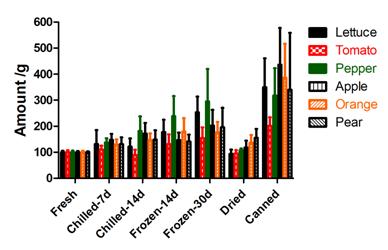










|
Title of Talk Chemistry behind diet: Effects of Processing Treatments on effective serving amount of Fruit and Vegetables
Abstract Different forms of food have distinctive nutritional and functional values, largely depends on their chemical components and contents. Fruit and vegetables (F & V), as an example, low F & V consumption is widely existed. Due to the different processing treatments and eating habits, the effective attributes of fruit and vegetables eventually consumed are not well known. To better define a serving amount of F & V, a comparative study with differently processed F & V was conducted. Apple, orange, pear, lettuce, pepper and tomato were chosen with canned, dried, refrigerated, frozen and fresh as processing methods. Vitamins including ascorbic acid, total carotenoids and folate, and non-vitamin phytochemicals including total phenolic content, total flavonoid content and lycopene, and antioxidant activity were examined. Serving amount of processed F & V was converted to their 100 g fresh counterparts base on the above attributes. In average, 118 g of dried (made from approx. 1000 g fresh), 338 g of canned while 143 g of refrigerated with 2 weeks and 213 g of frozen had equivalent serving amount of 100 g fresh counterparts. These results help design products and direct consumers to obtain enough nutrients and attributes when taking processed F & V.
Figure 1. Equivalent amount based on phytochemicals and antioxidant activity between fresh and processed fruit & vegetables
References: 1. Jiménez-Monreal, A. M.; García-Diz, L.; Martínez-Tomé, M.; Mariscal, M.; Murcia, M. A J. Food Sci. 2009, 74, H97 2. Alvarez-Parrilla, E.; de la Rosa, L. A.; Amarowicz, R.; Shahidi, F. J. Agric. Food Chem. 2011, 59, 163 3. Hervert-Hernández, D.; Sáyago-Ayerdi, S. G.; Goni, I. J. Agric. Food Chem. 2010, 58, 3399 4. Montero-Calderón, M.; Rojas-Graü, M. A.; Aguiló-Aguayo, I.; Soliva-Fortuny, R.; Martín-Belloso, O. J. Agric. Food Chem. 2010, 58, 5042 |
|
Hongshun Yang, Assistant Professor
Food Science and Technology Programme, Department of Chemistry, National University of Singapore, 117543 SINGAPORE e-mail: chmynghs@nus.edu.sg
Dr. Yang has published 45 articles in international peer-reviewed journals, one edited scientific book and 5 patents licensed or applied. Dr. Yang won PepsiCo Research Competition in 2011 and he is the only receipt in food science being awarded ‘In Recognition of Excellence in Research’ by New York Academy of Science two times. Dr. Yang’s overall research interests are sustainable food processing and safety engineering, which includes Organic Food Processing; Food Safety Engineering; Sustainable Food Processing via Byproduct Utilization; Food Nanotechnology; Rapid Detection of Hazards for Food Defense; and Food Security. The goal is to provide valid solutions to improve our capability in food security and defense in addition to sustainability. Dr. Yang has also established a strong collaboration with food companies like PepsiCo Inc.
Selected Publications 1. Yang, H.; Hewes, D.; Salaheen, S.; Federman, C.; Biswas, D. Food Control 2014, 37, 15 2. Wang, H.; Chen, F.; Yang, H.*; Chen, Y.; Zhang, L.; An, H. Carbohydr. Polym. 2012, 89, 1180 3. Chen, F.; Liu, H.; Yang, H.*; Lai, S.; Cheng, X.; Xin, Y.; Yang, B.; Hou, H.; Yao, Y.; Zhang, S.; Bu, G.; Deng, Y. Food Chem. 2011, 126, 450 4. Zhang, L.; Chen, F.; Yang, H.*; Sun, X.; Liu, H.; Gong, X.; Jiang, C.; Ding, C. LWT-Food Sci. Technol. 2010, 43, 26 5. Yang, H.; Wang, Y. Food Hydrocolloid. 2009, 23, 577 |

